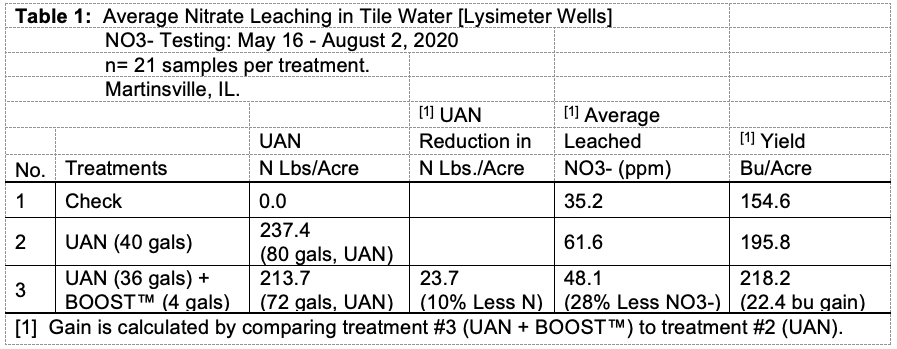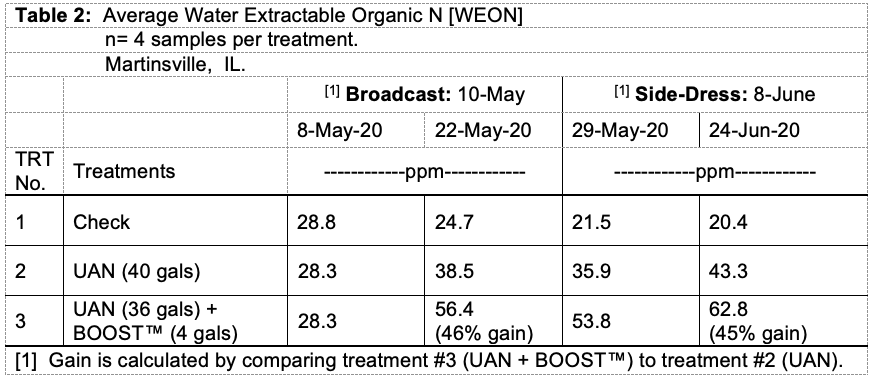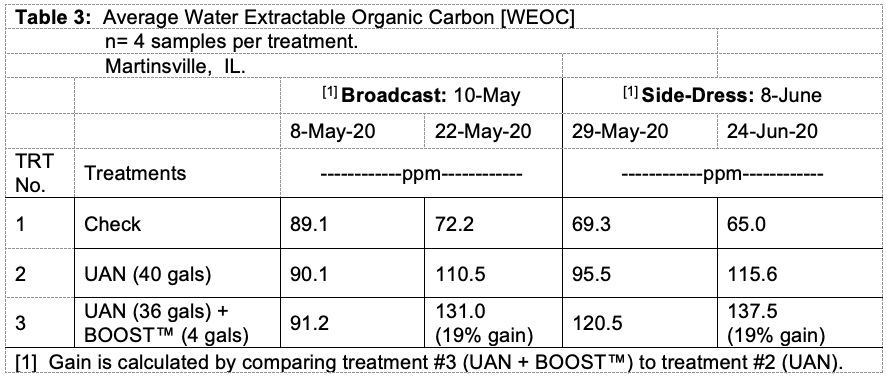by Greg Clark, M. Sc, AgC, Agronomy Researcher
A water nitrate (NO3–) leaching study was implemented in 2020 in Martinsville, Illinois. The objective of the study was to continue to corroborate if L-CBF BOOST (4-0-3-2S) when tank-mixed with 28% UAN will decrease NO3– leaching in field tiles along with improving soil health when compared to UAN treatment only. There were twelve plots and all plots had twenty-four-inch diameter wells (lysimeter wells) for holding discharge from each plot’s tile line. Seven samples were taken out of each well after a substantial rainfall for each treatment for NO3- analysis. Soil health was measured by taking soil samples before the broadcast program and then two-four weeks later. The same procedure was used for the side-dress program. The treatments consist of:
- Check (Water). No nitrogen (N) was applied in the check.
- 28% UAN (40 gallons at broadcast and side-dress). Total N: 237.4 lbs per treatment.
- L-CBF BOOST with 28% UAN (4 gallons of BOOST and 36 gallons of UAN at broadcast and side-dress). Total N: 217.3 lbs/treatment.
All forms of N fertilizer are subject to subsequent losses of N. The probability of loss hinges on various variables.
- Field
- Climate conditions
- Fertilizer forms
- If a stabilizer was used
- Biology activity in the soil.
Let’s take a refresher course on Fertilizer 101 on the movement of N in the soil. Urea-ammonium nitrate (UAN) solutions are mixtures of UREA, ammonium nitrate, and water in various proportions. 50% of the actual N in UAN is amide (from UREA), the other 50% is ammonium, NH4+ (25%) and NO3- (25%). Since NH4+ is a positive ion, NH4+ reacts and binds with negatively charged soil constituents including clay and organic matter. Thus, NH4+ is held on the soil exchange complex and is not subject to movement with water. Oppositely, NO3- is negatively charged. NO3- will not adhere to organic matter or clay particles but instead, NO3- will occur as an anion in the soil solution, thus moves with water and is subject to loss by leaching or denitrification.
Table 1 elucidates that the BOOST treatment used eleven percent less UAN (23.7 lbs of N/acre), thus unveiling a twenty-eight percent reduction in NO3- leaching concentrations (13.5 ppm per tile water) while demonstrating a twelve percent gain in bushels (22.4 bushels/acre). Over the past five years, QLF research has proven that BOOST has the capability of maintaining N in the soil. To keep facts straight, BOOST is not an N stabilizer. BOOST doesn’t contain any compounds that slow the conversion of NH4+ to NO3-therefore, elongating the point of time that N is in the “shielded” form, and reducing its loss from the soil.

The addition of BOOST to treatment three reduced the amount of NO3- in the wells while increasing yields on less total N lbs/acre, but how? BOOST while providing chemistry, also provides food (carbon) to soil microbes colonies, thereby improving mineral nutrition uptake to the plant by working closely with the rhizosphere (microbiome structures) and plant root exudates (Jacoby et al., 2017). Soil microbes in the soil are openly joined to nutrient recycling especially carbon, nitrogen, phosphorus, and sulfur. These microorganisms are the mechanism that keeps soils healthy and productive and lessens the movement of NO3- in field tiles.
To help determine the number of nutrients that are accessible to soil microbes, the Haney Test was implemented in the study. The Haney Soil Health Test (developed by Rick Haney of USDA-ARS) is designed to retrieve data on soil health by establishing a baseline of soil health for that location by utilizing specific lab soil extracts that include water, soil microbial indicator, and a weak organic acid (H3A) (Singh et al., 2020). Along with determining nutrients availability to microbes, the Haney Test also evaluates soil health by looking at soil respiration (CO2 Burst), water-soluble organic N, and carbon (WEON and WEOC).
Table 2 shows the amount of water-extractable organic N (WEON) in each treatment (taken at broadcast and side-dress). WEON is the amount of the total water-extractable N minus the inorganic N (NH4-N + NO3-N). WEON epitomizes the collective of organic N that is accessible to the microbe colonies. Consider organic N as amino acids and proteins, which are connected to the carbon (food) that the microbe colonies are consuming. The data demonstrates how easily N is broken down by soil microbes and released to the soil in inorganic N forms, thus are readily plant available and not a loss by leaching. The UAN with BOOST treatment had less N at the beginning but ended up having a 17.9 gain in WEON (ppm) during the broadcast timeframe and a 14.4 WEON (ppm) increase during the side-dress period when compared to the UAN treatment.

WEOC is a measure of the organic carbon that is most readily available to the microbes. Don’t confuse WEOC with total soil organic matter (SOM). For example, a three percent SOM will have roughly 18,000 ppm of carbon. However, when the same soil is subject to water extract analysis, those amounts could range from 150-350 ppm carbon. The organic carbon in the soil water extract indicates that the carbon in the soil is vastly linked to microbial activity in the soil. Just think of SOM (%) as the quantity of organic carbon whereas WEOC is about quality.
As shown in table 3, the addition of BOOST had a nineteen percent increase in WEOC for both analyses at broadcast and side-dress. Typically, the greater the amount of WEOC there is, the better chance there is more food obtainable to run the soil microbial structure. There is a mutually beneficial symbiotic relationship between soil microorganisms and BOOST. By supplying food for the soil microbes with BOOST, the microbes metabolize recalcitrant forms of soil nutrients, thus releasing these elements for plant nutrition (i.e., taking unavailable organic minerals and mineralized them to an inorganic source for plant availability).

Managing NO3- leaching from tiles is an achievable goal that the QLF Agronomy Team can assist with. QLF’s L-CBF products not only supply carbon (food) for soil microorganisms, but L-CBF products also provide a balanced nutritional program by adding chemistry and biology to the soil, thus providing a unique symbiotic relationship between plants and soils. For more information on this study or inquiries on QLF L-CBF products, contact your local Regional Sales Agronomist.
References:
Jacoby, R., Peukert, M., Succurro, A., Koprivova, A., Kopriva, S. (2017). The Role of Soil Microorganisms in Plant Mineral Nutrition—Current Knowledge and Future Directions. Frontiers in Plant Science doi: 10.3389/fpls.2017.01617.
Singh, S., Jagadamma, S., Yoder, D., Yin, X., Walker, F. (2020). Agroecosystem management responses to Haney soil health test in the southeastern United States. Soil Science Society of America Journal, doi: 10.1002/saj2.20131.
